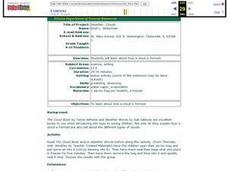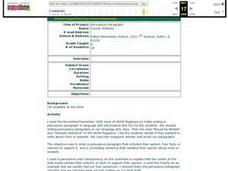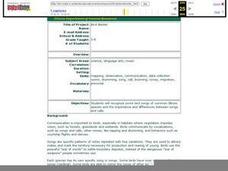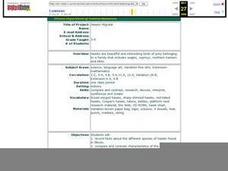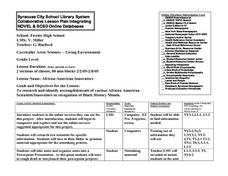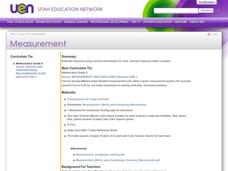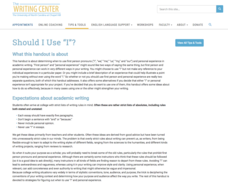Curated OER
Native American Trivia Book
Fourth graders research information about the Eastern Woodland Indians for a class trivia book. They Save, proofread, and print out their trivia sheet and design a cover page for the book.
Curated OER
Science: Spider Models
First graders create spider models to discover its anatomy. They use construction paper and sequins to make their spiders and use pictures as examples for their models. As an alternative, 1st graders make posters of the spider's parts....
Curated OER
Weather: Clouds
First graders discover how clouds are formed and how they affect weather. After being read a book, they place air into a Ziploc bag and place it in the freezer. They discuss the results and take a walk outside to observe real clouds.
Curated OER
Writing Persuasive Paragraphs
Fourth graders discover a fun-filled way to write persuasive paragraphs. After reading stories about mice and weasels, they choose which animal to be their topic. Students use a web outline to organize their opinion, four supporting...
Curated OER
Amazing Bird Adaptions--Why Am I A Bird?
Fourth graders identify and classify birds found in Illinois. Using the internet, they discover how birds have adapted over time and how the adaptations have increased their life span. They compare and contrast the various adaptations...
Curated OER
Bird Banter
Learners listen to examples of common bird songs of birds found in Illinois. As a class, they discover the importance between the differences in songs and calls. They practice making their own bird calls and songs to end the lesson plan.
Curated OER
Hawks Migrate
Students examine the types of hawks found in Illinois and compile a list of them. Using different species of hawks, they compare and contrast their characteristics. They work together to create their own hawk model for the classroom.
Curated OER
The Water Cycle: Transpiration
Young scholars identify and describe the stages in the water cycle. Using plants, they determine if they play a role in the cycle and measure the water the plants give off. They complete an experiment to determine if deciduous or...
Curated OER
The Odyssey Plan
Ninth graders read and analyze The Odyssey. They apply note-taking skills to identify enemy, type of enemy, and traits demonstrated throughout the book. Students create a storyboard that illustrates the selected episode from the book...
Curated OER
3 Branches of Governement
Sixth graders use the "Making the Grade" books, citizenship packets, and the "Ben's Guide" website to create a poster and a report on their assigned government branch. They then present their poster and report to their classmates.
Curated OER
Bon Voyage - Literature Travel Unit
Eighth graders locate and interpret information about the culture of another country using multi-media tools. Students read and interpret literature about characters and cultures from a foreign country. Students create a travel guide...
Curated OER
Mapping The Way With Lewis & Clark
Fourth graders analyze and compare maps used on the expedition of Lewis and Clark. Students write reports about the geography of the land. They answer questions about Lewis & Clark.
Curated OER
The Water Cycle
First graders investigate the different stages of the water cycle. They conduct Internet research and complete a water cycle WebQuest. Students identify what happens at each stage of the water cycle, and write about each stage in their...
Curated OER
The Giant Cell
After actively participating in a unit on cells, the students act out and become the organelles. They will act out and explain the functions of what each of the organelles do for the cell.
Curated OER
African-American Innovators
Learners investigate the contributions of African Americans throughout history. They research and identify accomplishments of various African American Scientists/Innovators in recognition of Black History Month.
Curated OER
Power In The Wind
Middle schoolers experiment designing graphs of selected readings from the Nebraska sites from the Power in the Wind study. They choose whether or not to put their data in a spreadsheet program to make a computer-generated graph or to...
Curated OER
Population Density in the Ghettos
Students examine population density in Jewish ghettos. In this Holocaust lesson plan, students calculate population density of cities around the world using the provided information. Students then discuss the implications of high...
Curated OER
Entertainment During the American Revolution
What do people do for fun around here? Explore colonial period games, toys, and life with a look at entertainment during the American Revolution. Discover the games, sports, and songs that were popular during the time of the Revolution.
Curated OER
American Focus on World Constitutions
Eighth graders describe essential components of a constitution and cite cultural factors affecting international law-making.
Curated OER
Measurement
Students explore the concept of measurement. In this measurement instructional activity, students discuss what specific measurement tools such as an odometer measure. Students recite a measurement poem. Students make a foldable with...
Curated OER
Chocolate Chip Cookie Mining
Students explore nonrenewable energy resources. In this coal lesson, students investigate how coal is formed and how it is used as a source of energy. Students mine for "coal" using toothpicks and chocolate chip cookies.
University of North Carolina
Should I Use “I”?
Despite the formal nature of academic writing, personal pronouns frequently appear in high school and college papers. While your first instinct may be to cross them out, sometimes it's okay to use them, an idea covered in a handout that...
Curated OER
Farm Animals
Why are farm animals important to the community? Expand young farmers' knowledge of furry and feathered friends through stories and a video. There are several books recommended; however, you could use any book about farm animals. A video...
Curated OER
Measuring Activities
Students measure using both metric and standard measures. They convert from one standard to the next while measuring distances in their home or classroom.


